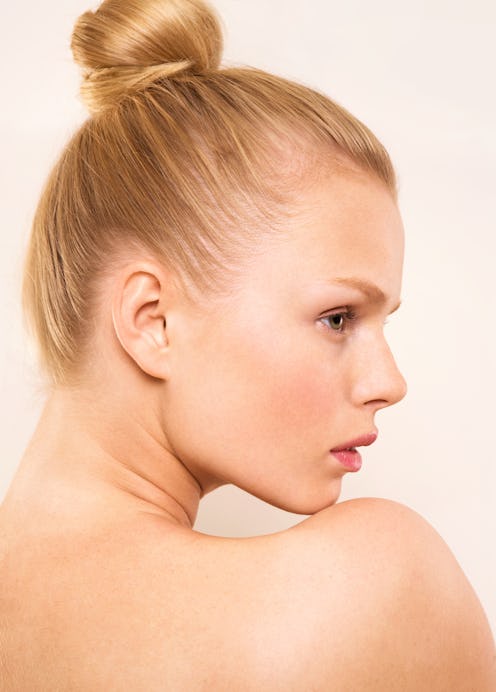(Skin)
This Game-Changing Filler Is The Answer To Buccal Fat Repair
Meet Renuva.

Right now, no three words on TikTok are as controversial as “buccal fat removal”. With an infinite scroll FYP, viral beauty trends on the social media app tend to have short lifespans, but this particular cosmetic procedure continues to be a hot-button topic on the app as users share their experiences undergoing buccal fat removal for a chiseled face, speculate which celebrities have had it, or a little bit of both.
What often isn’t included in these three-minute videos is that some people lose a portion of their buccal fat naturally with age. This may be a cause for someone in their 50s or 60s to want to boost volume in their cheeks to minimize gauntness. And for someone who had buccal fat removal when they were younger, it may be a cause for restoration because their face could now look excessively hallow.
The good news is plastic surgeons can restore buccal fat loss with autologous fat grafting. The even better news is that there’s a new facial filler on the market that can restore volume to this area of the face with just a needle. Enter Renuva, an injectable that replaces fat loss with the body’s own fat. Ahead, TZR spoke with Dr. Paul Jarrod Frank, cosmetic dermatologist, and Dr. Andrew Jacono, facial plastic surgeon, to learn how Renuva can be used to restore buccal fat, and who is the ideal candidate for buccal fat removal in the first place.
First, What Exactly Is Buccal Fat Removal?
Buccal fat removal – AKA cheek reduction surgery – is a surgical procedure that removes the buccal fat pad found in the hallows of the cheeks. According to the American Society of Plastic Surgeons, “Buccal fat pad extraction surgery is typically not performed in people with thin, narrow faces as removal of the fat may cause the face to look more gaunt with age.”
Dr. Jacono explains that unless the face has excessive cheek fat, there’s no point in performing the procedure because of the long-term implications. “Years ago, in the ‘70s and ‘80s, young women got buccal fat reduction because it highlighted their cheekbones – even if they if they didn’t need it,” he says. “Fast forward 15-20 years later, and they ended up looking gaunt. That’s where all of this concern about buccal fat reduction comes from.”
The surgeon also explains that today, the entire buccal fat pat isn’t typically removed. “There’s a lot of controversy around it [buccal fat removal] because it’s a procedure – like any in plastic surgery – that can be overdone.”
As for restoring buccal fat, he says the natural decline of buccal fat due to aging is the leading cause for repair in his office, and he often performs it in conjunction with a face lift.
How Does Renuva Work?
Renuva is an FDA-regulated, permanent, bio-stimulatory injectable that adds volume back to the face and body by stimulating the body’s production of healthy fat cells. Derived from donated and purified human fat (like from heart valves), Dr. Frank says Renuva contains the same growth factors, protein, and collagen, as your own fat, which creates a connective tissue matrix, which grow into new fat cells.
Before Renuva was an option, Dr. Frank says other bio-stimulants like Sculptra or hyaluronic acid fillers were used to add volume back to the face, whether the loss was natural or surgical. “These fillers work to restore the volume, but the problem is you’re adding more maintenance and expense to someone’s anti-aging routine because someone who is looking gaunt from a surgery at 30, is going to need a lot of filler at 50.” Unlike Renuva, Sculptra and HA fillers aren’t permanent.
What Are The Side Effects Of Renuva?
While Dr. Frank says the needle used to administer Renuva is larger than what’s used with other injectables, local anesthesia is used, so expect no more no less discomfort. Downtime is minimal, with the possibility of light swelling or bruising.
How Long Does It Take To Work?
Because fat cells take time to grow, don’t expect to see results in a few days. Dr. Frank says it can take four to six weeks for Renuva to run its course, and depending on the treatment area and its size, a patient may need one to three series of injections.
How Much Does Renuva Cost?
Let’s cut to the chase: Renuva is pricey compared to other fillers. While cost can vary based on location and the medical professional administering it, Dr. Frank says Renuva is around $3,500 a treatment.
How Long Does Renuva Last?
The cost of Renuva compared to other injectables might cause sticker shock, but in the long run, it’s a more affordable option for volume restoration compared to other fillers because the results can last up to 10 years.
This is what makes Renuva a desirable alternative to autologous fat transfer. “Renuva can be an option for someone who has trauma to to a specific area of the body, like if someone has melanoma removed on their back,” Dr. Frank shares. “Bio-stimulants like Sculptra aren’t permanent, so you have to get the treatment every one or two years to maintain results.”
This article was originally published on